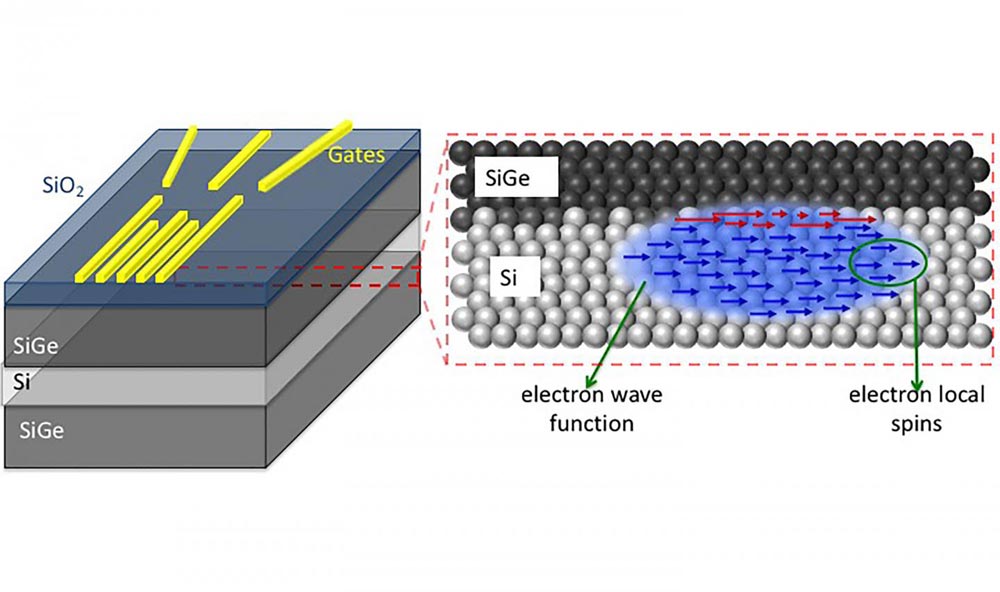
Silicon Quantum Chip Controls Qubits for Faster Algorithms

Researchers are taking advantage of a newly found phenomenon in silicon that makes quantum bits easier to manipulate, leading to faster and longer-lived information processing via quantum computing.
Credit: Purdue University image/Rifat Ferdous
A silicon quantum computer chip has the potential to hold millions of quantum bits, or qubits, for much faster information processing than with the bits of today's computers. This translates to high-speed database searches, better cybersecurity and highly efficient simulation of materials and chemical processes.
Now, research groups from Purdue University, the Technological University of Delft, Netherlands and the University of Wisconsin-Madison have discovered that silicon has unique spin-orbit interactions that can enable the manipulation of qubits using electric fields, without the need for any artificial agents.
“Qubits encoded in the spins of electrons are especially long-lived in silicon, but they are difficult to control by electric fields. Spin-orbit interaction is an important knob for the design of qubits that was thought to be small in this material, traditionally,” said Rajib Rahman, research assistant professor in Purdue's School of Electrical and Computer Engineering.
The strength of spin-orbit interaction, which is the interaction of an electron's spin with its motion, is an important factor for the quality of a qubit. The researchers found more prominent spin-orbit interaction than usual at the surface of silicon where qubits are located in the form of so-called quantum dots – electrons confined in three dimensions. Rahman's lab identified that this spin-orbit interaction is anisotropic in nature – meaning that it is dependent on the angle of an external magnetic field – and strongly affected by atomic details of the surface.
“This anisotropy can be employed to either enhance or minimize the strength of the spin-orbit interaction,” said Rifat Ferdous, lead author of this work and a Purdue graduate research assistant in electrical and computer engineering. Spin-orbit interaction then affects qubits.
“If there is a strong spin-orbit interaction, the qubit's lifetime is shorter but you can manipulate it more easily. The opposite happens with a weak spin-orbit interaction: The qubit's lifetime is longer, but manipulation is more difficult,” Rahman said.
The researchers published their findings on June 5 in Nature Partner Journals – Quantum Information. The Wisconsin-Madison team fabricated the silicon device, the Delft team performed the experiments and the Purdue team led the theoretical investigation of the experimental observations. This work is supported by the Army Research Office, U.S. Department of Energy, the National Science Foundation and the European Research Council.
Upcoming work in Rahman's lab will focus on taking advantage of the anisotropic nature of spin-orbit interactions to further enhance the coherence and control of qubits, and, therefore, the scaling up of quantum computer chips.
###
ABSTRACT
Valley dependent anisotropic spin splitting in silicon quantum dots
Rifat Ferdous1, Erika Kawakami2, Pasquale Scarlino2, Micha? P. Nowak2,3, D. R. Ward4, D. E. Savage4, M. G. Lagally4, S. N. Coppersmith4, Mark Friesen4, Mark A. Eriksson4, Lieven M. K. Vandersypen2 and Rajib Rahman1
1Purdue University, West Lafayette, IN, USA
2Technical University of Delft, Delft, Netherlands
3AGH University of Science and Technology, Krakow, Poland
4University of Wisconsin-Madison, Madison, WI, USA
doi: 10.1038/s41534-018-0075-1
Spin qubits hosted in silicon (Si) quantum dots (QD) are attractive due to their exceptionally long coherence times and compatibility with the silicon transistor platform. To achieve electrical control of spins for qubit scalability, recent experiments have utilized gradient magnetic fields from integrated micro-magnets to produce an extrinsic coupling between spin and charge, thereby electrically driving electron spin resonance (ESR). However, spins in silicon QDs experience a complex interplay between spin, charge, and valley degrees of freedom, influenced by the atomic scale details of the confining interface. Here, we report experimental observation of a valley dependent anisotropic spin splitting in a Si QD with an integrated micro-magnet and an external magnetic field. We show by atomistic calculations that the spin-orbit interaction (SOI), which is often ignored in bulk silicon, plays a major role in the measured anisotropy. Moreover, inhomogeneities such as interface steps strongly affect the spin splittings and their valley dependence. This atomic-scale understanding of the intrinsic and extrinsic factors controlling the valley dependent spin properties is a key requirement for successful manipulation of quantum information in Si QDs.












